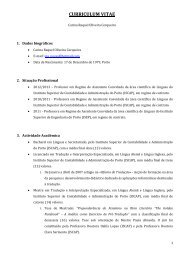para uma leitura não-biográfica da obra de mário de sá-carneiro
para uma leitura não-biográfica da obra de mário de sá-carneiro
para uma leitura não-biográfica da obra de mário de sá-carneiro
Create successful ePaper yourself
Turn your PDF publications into a flip-book with our unique Google optimized e-Paper software.
196 polissema 7 2007<br />
O romancista refere-se ao episódio em que Ignatius sobe as esca<strong>da</strong>s “in his cloth<br />
slippers” (CBP: 227), sem que os patrões notem a sua presença, ouvindo o casamento<br />
simbólico <strong>de</strong> Martha e Thomas. Essa imagem do empregado sínico com chinelos<br />
silenciosos é utiliza<strong>da</strong> no início e a meio do texto (16, 162) <strong>para</strong> pre<strong>para</strong>r este episódio e<br />
caracterizar a personagem colectiva chinesa. As estratégias e formas <strong>de</strong> representação <strong>de</strong><br />
CBP assemelham-se às utiliza<strong>da</strong>s por antropólogos, tais como o comentário em torno <strong>da</strong><br />
alteri<strong>da</strong><strong>de</strong>, ou seja, do Outro civilizacional, e a contextualização cultural, aproximando a<br />
<strong>obra</strong> <strong>de</strong> <strong>uma</strong> monografia etnográfica, exigência do romance histórico (Puga: 2006), pois o<br />
leitor <strong>de</strong>verá ser familiarizado com um tempo e espaço distantes (a Macau setecentista),<br />
e, no caso <strong>de</strong> CBP, <strong>uma</strong> cultura diferente, po<strong>de</strong>ndo o processo <strong>de</strong> selecção <strong>de</strong> material<br />
etnográfico a inserir num romance histórico ser analisado à luz <strong>da</strong> seguinte afirmação <strong>de</strong><br />
Thomas G. Winner (1988: 52):<br />
[The] historical novel […] can lay claim to a high <strong>de</strong>gree of homomorphy between text and<br />
life […]. Utilizing the terminology of the Russian formalists, we may say that a historical novel<br />
transforms the fabula of the historic events into the sujet of the novel; or that it transforms raw<br />
historical <strong>da</strong>ta into what Genette [...] called a récit, by removing facts from their historical<br />
sequentiality […], and by reor<strong>de</strong>ring these facts to fit into the artistically rearranged sequence of<br />
the novel.<br />
Se a representação literária <strong>de</strong> comuni<strong>da</strong><strong>de</strong>s, tradições e locais <strong>da</strong> Macau<br />
setecentista na narrativa po<strong>de</strong> ser interpreta<strong>da</strong> à luz <strong>de</strong> estudos históricos e antropológicos<br />
sobre o território (Cabral e Lourenço: 1993), também a forma como esse processo tem<br />
lugar nos permite i<strong>de</strong>ntificar em CBP <strong>uma</strong> dimensão etnohistórica 2 . O leitor informado<br />
reconhece assim as personagens e os acontecimentos históricos ficcionalizados, bem<br />
como quadros h<strong>uma</strong>nos e costumes <strong>de</strong> <strong>uma</strong> Macau há muito <strong>de</strong>sapareci<strong>da</strong> e que enriquece<br />
2 Sobre as relações entre Antropologia, Literatura e Estudos Literários, nomea<strong>da</strong>mente no âmbito <strong>da</strong>s<br />
chama<strong>da</strong>s Antropologia <strong>da</strong> Literatura e Antropologia/Etnocrítica do Romance, vejam-se: Poyatos (e d.),<br />
1988; Dennis e Aycock (eds.), 1989; Iser, 1993a: ix -21, 171-303; 1993b: 262-284; Benson (ed.), 1993;<br />
Daniel e Peck (eds.), 1996; Girard, 1997: 9-17, 143-160; Domínguez (ed.), 1997; Rapport, 1997: 1-29, 164-<br />
179; Scarpa, 2000 e Assmann, 2000: 199-215.



